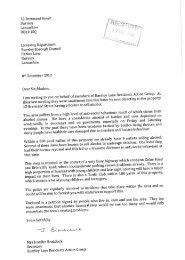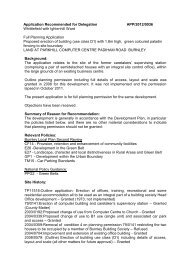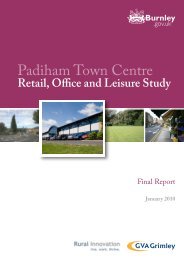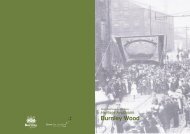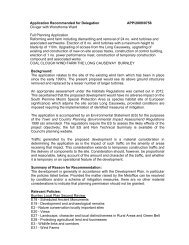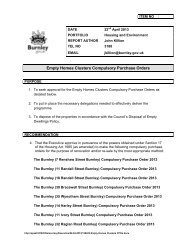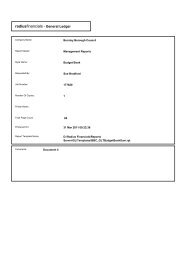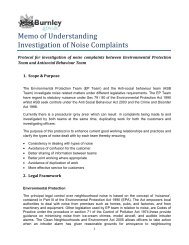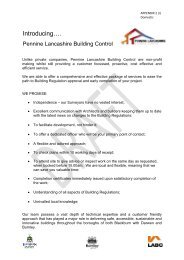The Padiham Heritage Appraisal - Burnley Borough Council
The Padiham Heritage Appraisal - Burnley Borough Council
The Padiham Heritage Appraisal - Burnley Borough Council
- No tags were found...
Create successful ePaper yourself
Turn your PDF publications into a flip-book with our unique Google optimized e-Paper software.
6.2. Movement And Key Routes6.2.1 Within the character area the only existing roads shown on the OS 1844 map (PlanB), were <strong>Burnley</strong> Road, Green Lane and the early stages of what is now Victoria Road toStockbridge House, which was the only settlement existing within the character area at thattime. Beyond Stockbridge House a track led to the farm at Scolebank to the south.6.2.2 Movement within the character area is constrained by physical barriers, the RiverCalder, Green Brook and the railway embankment, which have influenced the form and layoutof the settlement. Bridges/crossing points over the river, brook and railway are a feature of thecharacter area. <strong>The</strong>se are discussed in more detail below. More recently, traffic levels on themain <strong>Burnley</strong> Road have become a different kind of barrier to movement.6.2.3 <strong>Burnley</strong> Road, Green Lane (public transport routes) and Victoria Road bear most ofthe local traffic. Other key routes are those which, like Green Lane, pass over or under therailway line: Dryden Street, Shakespeare Street and Pendle Street. <strong>The</strong> disused railway lineitself is an important, though underdeveloped, route and link to other parts of the town (Plan F).<strong>Padiham</strong> Bridge and River Footbridges6.2.4 <strong>Padiham</strong> Bridge over the River Calder, which links thecharacter area with <strong>Padiham</strong> town centre, is a landmark structurewhich is locally listed (Plan A). As its inscription indicates, theexisting stone-built twin-arched structure dates from 1904, thebridge and road layout having been redesigned and widened toremove the sharp bend which had previously proved troublesomeparticularly since the advent of trams in the 1880s (Haines andJones 1994). <strong>The</strong> road is clearly marked as the major route through<strong>Padiham</strong> on Yates 1786 map, having become, in 1754/5, partof the turnpike road from Blackburn to <strong>Burnley</strong>, the first in EastLancashire (Marshall et al, 2004) (Plan B). Maintenance of thebridge had, however, been crucial to <strong>Padiham</strong>’s development longbefore that (Haines and Jones 1994).6.2.5 A metal footbridge over Green Brook at the western edgeof the character area links Green Lane to Station Road (Area 5). Afootbridge appears to have been established here between 1892and 1910. On the C alder at the eastern edge of the character area,Bendwood footbridge opened in 1931 linking industrial areas onboth banks of the river.<strong>Padiham</strong> Bridge today looking south towards theBridge Inn.<strong>Padiham</strong> Branch Railway Line and Railway Bridges6.2.6 <strong>The</strong> 1.5 mile Rose Grove to <strong>Padiham</strong> section of the line,includes, within the character area, part of the 1 in 40 descent(known as <strong>Padiham</strong> Bank) and a tight westward curve, whichcommences towards the former site of <strong>Padiham</strong> station (see Area6). Very close to properties on both sides but particularly to thewest, the line’s embankment falls dramatically from near roof heightto ground level, and as such is a key visual landmark and heritagefeature (Plan F).Inscription, <strong>Padiham</strong> Bridge.heritage appraisal 53



